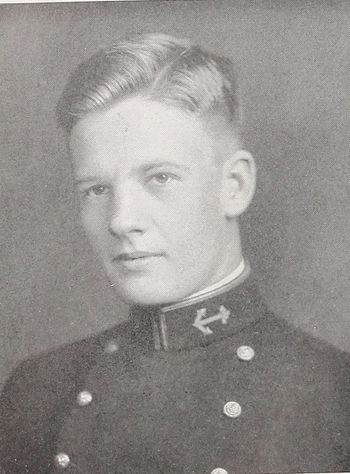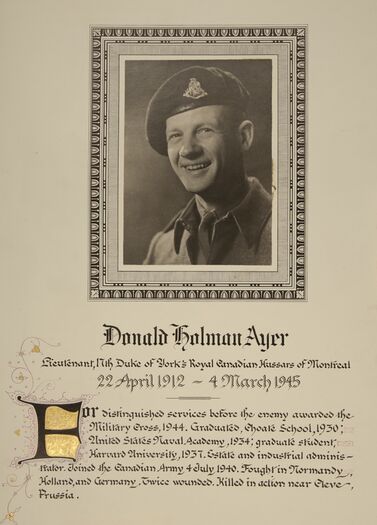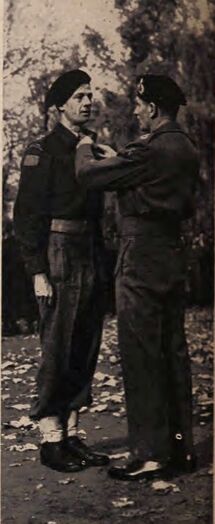DONALD H. AYER, 1LT, RCA
Donald Ayer '34
Lucky Bag
From the 1934 Lucky Bag:
DONALD HOLMAN AYER
Bangor, Maine
"Don"
DON came to us fresh from the cold north and .... naturally academics had no worries for him, and his class standing has since proved this. After we came to know him we found that he liked dogs, chess and strawberry sundaes. A good book would always keep him quiet for a while.
Although Don has not made a name for himself in athletics, he is rarely found on the radiator. If it were not a week-end he could usually be found on the tennis or handball courts or in the wrestling loft. During week-ends he usually can be found dragging, a snakish habit of which he quite approves. He has a penchant for Army Juniors.
All who know him, know of his ready wit and conversations. He doesn't say much about himself, but on any other topic is convincing and informing. He also has original ideas. Although the Exec. Department wouldn't let him decorate his room according to his own imagination, he's conceived the idea of little Frances Arabella Holman which ticks away the hours.
We are glad and consider ourselves lucky to have had Don for a classmate. His companionship and willingness to go out of his way to help one have won him many friends both at the Academy and in the neighboring cities.
Reception Committee. Class Wrestling. 1 P.O.

DONALD HOLMAN AYER
Bangor, Maine
"Don"
DON came to us fresh from the cold north and .... naturally academics had no worries for him, and his class standing has since proved this. After we came to know him we found that he liked dogs, chess and strawberry sundaes. A good book would always keep him quiet for a while.
Although Don has not made a name for himself in athletics, he is rarely found on the radiator. If it were not a week-end he could usually be found on the tennis or handball courts or in the wrestling loft. During week-ends he usually can be found dragging, a snakish habit of which he quite approves. He has a penchant for Army Juniors.
All who know him, know of his ready wit and conversations. He doesn't say much about himself, but on any other topic is convincing and informing. He also has original ideas. Although the Exec. Department wouldn't let him decorate his room according to his own imagination, he's conceived the idea of little Frances Arabella Holman which ticks away the hours.
We are glad and consider ourselves lucky to have had Don for a classmate. His companionship and willingness to go out of his way to help one have won him many friends both at the Academy and in the neighboring cities.
Reception Committee. Class Wrestling. 1 P.O.
Loss
Don was lost in the Battle of Hochwald Gap (aka Hochwald Forrest), a part of the Rhineland Campaign, on March 4, 1945. He was a 1st Lieutenant in the Royal Canadian Army.
Other Information
From researcher Kathy Franz:
Donald and his brother Nathan both attended Choate School in Connecticut. Donald was an associate editor of the 1929 yearbook, The Brief Board.
Their mother was Katherine, and their father was Nathan. In 1910, their father and grandfather Fred were manufacturers in a pulp, paper and lumber company called the Eastern Mfg. Co. Their father died in 1915.
In 1945, Donald’s cousin John Butler Ayer was a member of the Eagle Squadron. A squadron leader with a number of fighter planes under his command, he reportedly downed a German plane or two.
From The Bangor Daily News, March 19, 1945:
Lieut. Ayer resigned from the Navy upon graduation and was employed by Stephen Wheatland in the Pingree estate. After taking a year’s course at the Harvard Business school, he took a position as a mechanical engineer with the Union Carbon and Carbide company in Indianapolis.
In July, 1940, he joined the Canadian Army and was sent overseas the following year. He was graduated from the Royal Military academy at Sandhurst with the rating of first lieutenant, and a few days after D-Day, was sent to France in command of a detachment of men.
Lieutenant Ayer was wounded twice and decorated with the Military Cross for gallantry in action. This decoration was received from Marshal Montgomery last October.
From the Canadian Virtual War Memorial:
Age: 32
Force: Army
Unit: 17th Duke of York's Royal Canadian Hussars, R.C.A.C.
Division: 7th Reconnaissance Regt.
Cemetery: GROESBEEK CANADIAN WAR CEMETERY, Netherlands
Additional Information: Son of Nathan Chase Ayer and Katharine Holman Ayer, of Kittery Point, Maine, United States.
Donald is buried in the Netherlands.
Career
As with many of his classmates in 1934, his resignation was accepted immediately upon graduation from the Naval Academy. He later attended Harvard University as a graduate student.
In the February, 1946 issue of Shipmate, the Class Notes of 1934 include a full tribute to Don and his military career:
Don Ayer wasn't very widely known outside of the Second Batt. He was one of those who wasn't sure about the Navy in those uncertain days in 1934 and decided to try it on the outside. Those who stayed in and many of those who didn't probably lost track of Don after graduation. They did not know that in July of 1940, when the people of the U. S. hadn't made up their minds yet about fighting, Don joined the Canadian Active Service Force in order to get in the fight. Characteristic of his unassuming nature Don did not ask for a commission but joined as a Trooper. Later on he was promoted to Sergeant and, after being sent overseas he was graduated from Sandhurst and was commissioned a Lieutenant.
When the invasion came, Don got his wish to get in the thick of it. In the accompanying picture he is shown receiving the Military Cross from Marshal Montgomery for gallantly in action, with the following citation: "On 14, August, 1944, during the attack across the River Liaison, under direct enemy fire, recaptured a crossing of the river near Montboint for his entire squadron and then pushed forward with his section of 6 Carriers to the high ground at point 160 (1444) and although by this time severely wounded by MG fire through the chest, refused to leave the ground until his small force was organized to hold this vital point. This action relieved the entire crossing from observed fire and directly influenced the successful crossing of the entire Regiment."
After convalescing from his wounds Don again returned to his regiment in the front lines. In March of 1945 his luck ran out. Quoting from a letter from his commanding officer: ". . . B squadron was ordered to patrol to a little town called Sonsheck near the western bank of the Rhine in Germany. Donald's troop was chosen to do it and, as was typical of him, he led the patrol himself. As they approached the objective the patrol came under enemy mortar fire. They took to the ground. When the mortar fire lifted Donald saw that one of his men was sorely wounded and told the rest of the patrol that he was going to get him. As he proceeded to do so a German sniper fired at him. He died instantly . . . Donald Holman Ayer, a fine gentleman and a gallant soldier, will hold a high and honored place in the annals of the history of this Regiment."
Those of us who were shipmates with him from 1930 to 1934 knew him to be generous, unassuming, straightforward, a good companion and one whose name we hope will not soon be forgotten.
Via email from the author on August 18, 2019:
Lieutenant Donald Holman Ayer
During the first year or so in England, there was an acute shortage of subalterns, and some troops were run by senior non-commissioned officers. To remedy the deficiency, a number of sergeants underwent officer training in Canada (a 90-day course at Brockville), and the first group returned to the regiment on 12 November 1942. The previous day, three sergeants – including Don Ayer, who made a great name for himself in North-West Europe – left for an officers’ training course in England, the first individuals who underwent such training outside Canada.
In April 1942, Americans in Canadian ranks were given permission to get discharges in order to join the armed forces of the United States now that their country was at war. The regimental war diary reported that, of over fifty Americans in the 7th Reconnaissance Regiment, no more than six were contemplating making the switch. [War Diary, 19 April 1943. (T-12659).] One of those who elected to remain in the unit was Don Ayer, who hailed from Bangor, Maine. A graduate of the US Naval Academy, he had enlisted as a trooper in the 3rd Motorcycle Regiment when it was mobilized in July 1940. He was subsequently commissioned and launched an old-style cavalry charge – with carriers – at Gruchy on 9 July 1944, won the Military Cross and was killed weeks before the end of the war.
It has been said that reconnaissance units are “the last of the cavalry,” [Wolf Heckmann. Rommel’s War in Africa. (New York: 1981), 144.] and Lieutenant Don Ayer proved this in epic fashion during the attack on Gruchy on 8 July. The infantry were held up outside the village by heavy machine gun fire, so Ayer assembled all “B” Squadron’s carriers (15 or 16) and “without hesitation, he charged right through them, in real old cavalry style, right into the middle of an enemy Company position. With grenades and Bren guns (not to mention the ‘Ayer pistol’) firing at point-blank range, they drove the enemy from his dug-outs, killing dozens, wounding others and capturing 25 or 30 prisoners. This act of extreme gallantry on the part of all ranks allowed a complete battallion [sic] of infantry to advance into Gruchy.” [Pavey. An Historical Account, 47-48.] That same evening, Lieutenant Pavey, who was still on contact detachment duty, spoke to Lieutenant-Colonel G.H. Christianson, the commanding officer of the Stormont, Dundas and Glengarry Highlanders. Christianson told Pavey, “I’d like to thank that Officer. Without his aid along with his crazy carrier crews, I doubt very much if we would have got into Gruchy.” [Ibid, 48.] This action cost “B” Squadron two killed – Sergeant Bob McDougall and Trooper Doug Turner - along with two wounded (Ayer was one of them). The British official history described Ayer’s attack at Gruchy as a “somewhat unorthodox charge…in cavalry fashion…” [Major L.F. Ellis. Victory in the West. Volume 1. The Battle of Normandy. (London: 1962), 315.] that settled the issue in this sector.
Sergeant George Routley found a small bridge at Rouvres and seized the south bank of the River Laison, while on the right, Lieutenant Ayer discovered a small ford near Montboint, enabling “B” Squadron to establish a bridgehead, with a view to occupying it pending the arrival of heavier armour. Lieutenant Ayer pushed forward with six carriers to the high ground at Point 160 and, although severely wounded in the chest by machine gun fire, refused to be evacuated until his small force was organized to hold this vital point. This action relieved the entire crossing from observed fire, and directly influenced the crossing of the whole regiment. Ayer was awarded the Military Cross for this action. As Copp put it, the cars of the 7th Reconnaissance Regiment were “able to cross quickly and they boldly advanced to Point 159 on the south side of the river.” [Copp. A Canadian’s Guide to the Battlefields of Normandy, 131.] Point 159 was the dominating height above Falaise.
While in Ghent, on 5 November, 200 members of the regiment attended an investiture ceremony presided over by Field-Marshal Montgomery. Lieutenant Don Ayer and Lieutenant Terrence Brunstrom were both decorated with the Military Cross for their actions during the Falaise operation.
While the regiment’s losses during the generally static period between the launch of Operation Veritable and the end of March – five fatalities – were relatively light, one was felt particularly acutely within the unit. On the afternoon of 4 March, Lieutenant Ayer was tasked to “probe to Sonsbeck” from Udem. The fighting vehicles had become “practically useless by bogging down all over the place,” [Pavey. An Historical Account, 103.] so Ayer led a foot patrol from No.7 Troop along the road to Sonsbeck. It was covered by a carrier section and by two Daimlers which the troop had managed to un-bog. The patrol got to a point just south of the Hochwald Forest when it came under fire from a 20-mm cannon and multiple machine guns. After Corporal E.R. Johnson was wounded by a shell from a 20-mm gun, Ayer started over to help him. Before he got there he was hit and killed by another shell.
Pavey said of Ayer that he was “a truly great and brave soldier; one who was loved and admired by every member of the 17th Hussars.” [Ibid.] Pavey was not alone in his sense of loss. Lorne Stephen, by this time a lieutenant and a troop officer, wrote that, for him, Ayer’s death in a “miserable corner of Germany” was particularly upsetting. [Stephen. Bash On, Recce!, 153.] Anthony Kellett, Captain (Retired), Royal Canadian Hussars
Photographs

The "category" links below lead to lists of related Honorees; use them to explore further the service and sacrifice of alumni in Memorial Hall.

